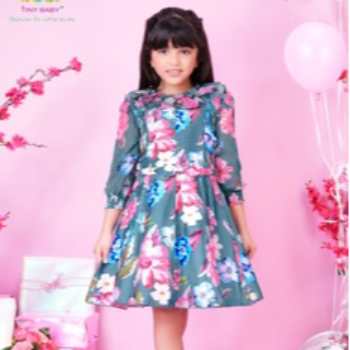In the bustling city of Mumbai, where the blend of tradition and modernity paints a unique cultural tapestry, 14-year-old Alisha faced a common challenge. As a vibrant teenager with a penchant for self-expression, Alisha often found herself grappling with the limited choices available in traditional attire. Her wardrobe dilemmas were not just a matter of style but a quest for identity and confidence.
Growing up in a city that never sleeps, Alisha was surrounded by influences from the West. Bollywood movies and pop culture icons fueled her desire to explore fashion beyond the traditional salwar kameez and lehenga choli. She longed for outfits that resonated with her evolving personality—a blend of Indian roots and a modern outlook.
One day, as she scrolled through the digital aisles of an online store, Alisha stumbled upon a collection of girls' western wear. The vibrant colors, chic designs, and contemporary styles caught her eye. It was a revelation—a solution to her longstanding wardrobe woes.
Alisha's major distinct problem was the lack of clothing options that aligned with both her cultural environment and her personal style aspirations. She needed outfits that allowed her to express her individuality without compromising on comfort or cultural sensibilities. The discovery of this western wear collection was nothing short of transformative.
The problem Alisha faced was not just about clothing; it was about confidence. Like many teenagers, she was navigating the tricky waters of adolescence, where self-esteem is often linked to one's appearance. Wearing outfits that made her feel out of place impacted her confidence, making social interactions daunting and leaving her feeling less than her vibrant self.
Enter the world of girls' western wear—a solution that bridged the gap between tradition and contemporary fashion. Alisha found dresses that were not only stylish but also comfortable and appropriate for various occasions. From casual outings to festive celebrations, she now had a wardrobe that celebrated her unique style.
The transformation was immediate. Alisha started wearing her new western outfits to school, family gatherings, and outings with friends. The compliments poured in, and with each outfit, her confidence soared. She felt seen and appreciated, not just for her fashion choices but for her boldness in embracing a style that was authentically hers.
This newfound confidence transcended her wardrobe. Alisha became more active in school events, took part in community activities, and even started a small fashion blog where she shared tips and styles with her peers. Her story is a testament to the power of fashion in shaping one's identity and boosting self-esteem.
Alisha's journey is a reflection of a broader trend among Indian teenagers who are increasingly embracing western wear as a form of self-expression. This shift is not just about following trends but about finding a style that resonates with their personal stories and aspirations.
Moreover, brands specializing in girls' western wear are responding to this demand by creating collections that cater to the diverse needs of Indian youth. They understand the cultural nuances and design outfits that are stylish, comfortable, and culturally sensitive.
In conclusion, the story of Alisha and her western wardrobe is more than a tale of fashion; it's about empowerment. For countless teenagers like her, western wear is more than clothing—it's a gateway to confidence, self-expression, and a celebration of individuality. As we celebrate this fusion of cultures, we are reminded that fashion is not just about what we wear but how it makes us feel.
So, if you or someone you know is on a quest for a wardrobe that speaks to their soul, consider exploring the vibrant world of girls' western wear. It might just be the key to unlocking a world of confidence and endless possibilities.
Visit Vyaparify Site:
https://id.vyaparify.com/olives 
